
Facebook Twitter Instagram YouTube RSS Feed
Written on: March 11th, 2019 in Outreach
by Brittany Haywood, DNREC Wetland Monitoring and Assessment Program
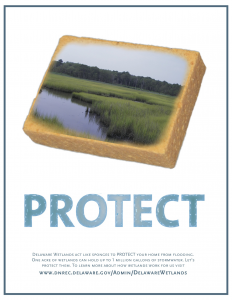 One part of our job is going out into the public and explaining simply our research and the benefits of wetlands. We often use the saying, “wetlands are like sponges” to describe their ability to absorb water, but recently we’ve been asked exactly how that is so.
One part of our job is going out into the public and explaining simply our research and the benefits of wetlands. We often use the saying, “wetlands are like sponges” to describe their ability to absorb water, but recently we’ve been asked exactly how that is so.
Describing wetlands as sponges dates back all the way to 1784 where Nicholas Turner described peat wetlands as, “in the nature of a sponge; for if a dry piece is put in water it will absorb double its weight” (Turner, 1757 p40). Since then this metaphor has been used all over the world to describe one of the many benefits that wetlands provide.
For this blog post we will explore the two linked concepts: one, how do sponges work, and two, how wetlands absorb water. Then, we will package it all up with a nice neat bow to make the connection that will hopefully satisfy all you knowledge seekers out there.
When you put a sponge in water, it absorbs it. This happens because the bubble like spaces inside the sponge have the ability to hold water and the sponge material locks it in. Water won’t be released until someone forces it out through squeezing or it could be allowed to dry out over time.
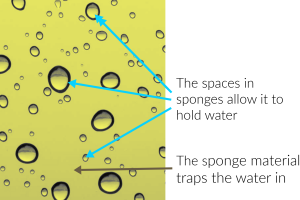 Also, have you ever noticed that it’s easier for a damp sponge to soak up water than a completely dry one? That’s because water is extremely sticky, and it sticks better to itself than anything else.
Also, have you ever noticed that it’s easier for a damp sponge to soak up water than a completely dry one? That’s because water is extremely sticky, and it sticks better to itself than anything else.
Nerdly speaking, water is a molecule made up of two hydrogen atoms and one oxygen atom. These molecules really like to form hydrogen bonds with each other, i.e. water loves to stick to itself. This is called cohesion. Water will also stick to other objects, like the dry sponge or soil, but it doesn’t do it quite as well. This is called adhesion. (Exploring Our Fluid Earth, 2019)
Wetlands are made up of wet soils, water loving plants, and of course, water. Soils have lots of spaces in between the soil particles called soil pores. And like the setup of the sponge, they can hold and trap water. How much water they hold onto depends on the pores sizes and soil type. Clay soils have small pores and trap water very well whereas sandy soils have larger pores allowing water to move more freely through it. Also these mineral type soils tend to attract water because of their unsatisfied ionic charge. (Nelson, 2015)
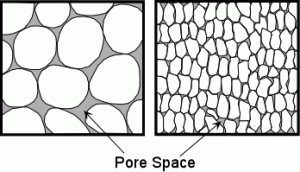
Pore spaces are in between the soil particles. The soil particles (soil material) trap the water. The two graphics represent two different soil types. (Nelson, 2015)
Wetland plants also play an important role in water absorption. These plants are specifically adapted to live in watery places. They absorb water and use what’s in it to grow. So not only do wetlands have water storage capabilities in their soils, they have it in their plants.
Water in wetlands is either released naturally and slowly over time to groundwater supplies, streams, or it evaporates. It can also be physically forced out by someone or something draining it.
As you have read above, water sticks to water better than dry objects so it would make sense that in order for a wetland to do its job, it needs to be wet. So draining wetlands may not be the best idea if you want to have a good functioning wetland.
So the long and short of it is both sponges and wetlands:
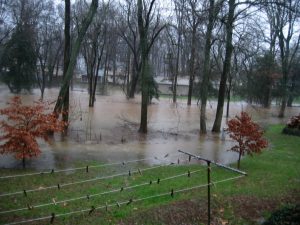
This wetland’s water carrying capacity has been reached and is now overflowing due to excess rainfall. (Lani Wall)
But wait, you’re probably thinking if wetlands absorb water, do they have a limit as to what they can hold?
Yes they do! Just like sponges, wetlands have a carrying capacity. So when the wetland becomes full you will see more pooling surface water, especially recently with all this rain we’ve been having in Delaware.
Now that you know how wetlands absorb and hold water, just think about how much more H2O you would see on our land surfaces if wetlands weren’t there or if a wetland’s soil pores got clogged up from super dirty water…
Exploring Our Fluid Earth. (n.d.). Hydrogen Bonds Make Water Sticky. Retrieved from https://manoa.hawaii.edu/exploringourfluidearth/chemical/properties-water/hydrogen-bonds-make-water-sticky
Nelson, S. A. (2015, November 11). Groundwater. Retrieved February 27, 2019, from https://www.tulane.edu/~sanelson/eens1110/groundwater.htm
Turner, Nicholas. An essay on draining and improving peat bogs; in which their nature and properties are fully considered. By Mr. Nicholas Turner, of Bignor, Sussex. London, MDCCLXXXIV. [1784]. Eighteenth Century Collections Online. Gale. CIC Penn State University. 25 Feb. 2019. <http://find.galegroup.com.ezaccess.libraries.psu.edu/ecco/infomark.do?&source=gale&prodId=ECCO&userGroupName=psucic&tabID=T001&docId=CW108495006&type=multipage&contentSet=ECCOArticles&version=1.0&docLevel=FASCIMILE>.
Written on: March 11th, 2019 in Wetland Restorations
Guest writer: Jules Bruck, University of Delaware
Great things come naturally in Laurel, Delaware including the new green infrastructure treatments that are popping up along the Broad Creek – home to the future Laurel Ramble.
This past summer the Sussex County Conservation District broke ground on a parcel of land in the center of the Ramble plan called Tidewater Park. The project, designed to improve water quality in the area, was engineered by ForeSite Associates of New Castle, DE.
Work began on two treatments – a vegetated bioswale and a constructed wetland, in early summer 2018.
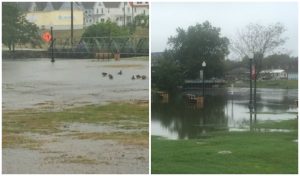
The Problems: Left image was taken of Broad Creek during a normal rain event in spring 2016. Photo credit: Matt Parker. Right, image taken of Broad Creek during historical flooding event on September 30, 2016. Photo credit: Ed Lewandowski
The bioswale was selected as a priority treatment due to the following factors:
The 300’ long gently meandering bioswale forms a diversion for runoff, permitting easier installation of the constructed wetland and fish habitat. It creates a viable, ecologically appropriate solution to aid in reducing pollutant loads to Broad Creek, which in turn makes a significant step forward toward meeting the demands of the town’s Municipal Separate Storm Sewer System (MS4) permit.
The bioswale represents a permanent change in drainage patterns on site, and it is expected to be a long-lived treatment as long as the inlet is regularly inspected and maintained. It’s designed to meet the total maximum daily load (TMDL) requirements for 2.23 acres of existing impervious surface in the drainage area.
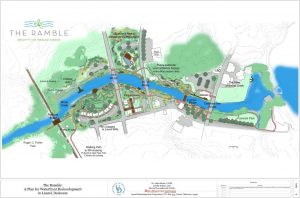
The Ramble Plan has driven efforts to redevelop Laurel’s waterfront since its acceptance in 2013. The project site is located on the north side of the river in between the 28A and Alt 13 bridges. Click on the image for a larger view.
The constructed wetland is approximately one acre is size, and planted with native grasses and sedges as well as some flowering herbaceous plants. It was designed to accept some stormwater surface flow from the upland areas as well as to allow the waters of the Broad Creek to enter during high tides.
According to the Stormwater Management Report prepared by FA in July 2016, “In keeping with the theme of the proposed playground as a nature-based feature and the Town’s goal to promote Laurel’s ecotourism industry, a tidal fish cell has been designed adjacent to the constructed wetland.”
“This tidal cell does not serve a regulatory function other than convey discharges from the constructed wetland to Broad Creek. Overflow from the constructed wetland is designed to discharge through a narrow v-shaped notch in the weir wall to help detain and slowly release runoff to the tidal fish area.”
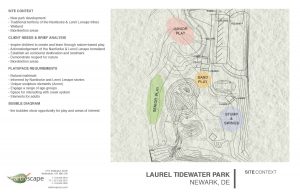
This figure shows the constructed wetland and bioswale treatments as well as future park amenities. The parking lot has been removed from the plan so there is more room for park elements. Click on the picture for a larger view.
The new landscape has diverse plantings that will increase the native biodiversity on site and attract wildlife such as ducks and butterflies. We look forward to the spring so we can evaluate how the plants survived over the winter.
We anticipate the wetland will become important habitat for spawning fish, such as American Shad. In fact, we had to be careful about working in the water during the summer to avoid disruptions during critical times for the local native fish.
After some minor touch ups and replanting of the plants that did not make it through the winter, the treatment should be relatively easy to maintain.
University of Delaware landscape architecture students worked on a landscape management plan under the direction of Dr. Jules Bruck thanks to funding from UD Community Engagement Scholars and DE Sea Grant. We continue to work with the Town of Laurel to develop a management plan.
We also want to keep an eye out for any invasive plants and provide training for the town’s landscape crews to help them identify and control non-native plants and noxious weeds. To that end, we’ve asked Tracy Wootten of Cooperative Extension to lend us a hand!
We are working on some ideas to engage facilities and the community so the project remains a benefit to all.
The Tidewater Park plan is a different type of landscape and you’ll start to see more of it as the Ramble plan is installed. It’s not just ornamental, it’s a working landscape.
This project was funded through two grants – the DNREC Community Water Quality Improvement Grant and the DNREC Chesapeake Bay Implementation Grant Program. Interested in learning more about this wetland and bioswale creation or the Laurel Ramble? Visit the Reimagining Laurel website. http://www.reimaginelaurel.net/